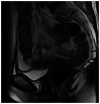Recurrent vaginal intraepithelial neoplasia successfully treated with topical imiquimod: A case report
- PMID: 32754333
- PMCID: PMC7391826
- DOI: 10.3892/mco.2020.2089
Recurrent vaginal intraepithelial neoplasia successfully treated with topical imiquimod: A case report
Abstract
Vaginal intraepithelial neoplasia (VAIN) is a rare disease associated with human papillomavirus infection. High-grade VAIN is typically treated with either excisional or ablative therapy. However, recurrent VAIN lesions are common and these treatments cause vaginal scarring. Recent studies have indicated that 5% imiquimod is an effective treatment for VAIN. The present report describes a case of a woman diagnosed with recurrent VAIN 3 who was treated with a 5% topical imiquimod cream and achieved a complete response after excision and CO2 laser vaporization. A 53-year-old, gravida 5, para 2 postmenopausal woman who was diagnosed with papillary squamous cell carcinoma by biopsy underwent conization, total abdominal hysterectomy and bilateral salpingo-oophorectomy. A histological examination revealed grade 3 cervical intraepithelial neoplasia with free surgical margins. At 3 years after the hysterectomy, the vaginal smear revealed atypical squamous cells, leading to a pathological diagnosis of VAIN 3. Partial vaginectomy was performed, and VAIN 3 was detected in the lesion with positive margins. At 4 months into follow-up, the vaginal smear revealed a high-grade squamous intraepithelial lesion (HSIL), and subsequent biopsy during colposcopy revealed a pathological diagnosis of VAIN 3. At 3 months after CO2 laser vaporization, the vaginal smear revealed HSIL with suspected recurrence and imiquimod treatment was initiated. One sachet of 5% imiquimod cream (0.25 g) was placed in the entire vagina three times per week for 14 weeks with no apparent complications. At 3 years after the treatment, there has been no recurrence. This case demonstrated that topical imiquimod with careful follow-up is an effective treatment for VAIN and is well-tolerated. Further clinical evidence of the effectiveness and safety of imiquimod in patients diagnosed with VAIN is required.
Keywords: imiquimod; non-surgical treatment; recurrence; side effects; vaginal intraepithelial neoplasia.
Copyright © 2020, Spandidos Publications.
Figures





References
-
- Tranoulis A, Laios A, Mitsopoulos V, Lutchman-Singh K, Thomakos N. Efficacy of 5% imiquimod for the treatment of Vaginal intraepithelial neoplasia-A systematic review of the literature and a meta-analysis. Eur J Obstet Gynecol Reprod Biol. 2017;218:129–136. doi: 10.1016/j.ejogrb.2017.09.020. - DOI - PubMed
LinkOut - more resources
Full Text Sources
